Using multiple variables in a For loop in Python
Last updated: Apr 10, 2024
Reading time·5 min

# Table of Contents
- Using multiple variables in a For loop in Python
- Declare as many variables as there are items in each tuple
- Using multiple variables in a For loop with two-dimensional list
- Using multiple variables in a For loop using dict.items()
- Using multiple variables in a For loop using enumerate()
- Using 2 variables in a For loop to simulate a nested loop
# Using multiple variables in a For loop in Python
To use multiple variables in a for loop:
- Use the
zipfunction to group multiple iterables into tuples. - Use a
forloop to iterate over thezipobject. - Unpack the items of each tuple into variables.
list1 = ['bobby', 'hadz', 'com'] list2 = [1, 2, 3] list3 = ['a', 'b', 'c'] for item1, item2, item3 in zip(list1, list2, list3): # bobby 1 a # hadz 2 b # com 3 c print(item1, item2, item3)
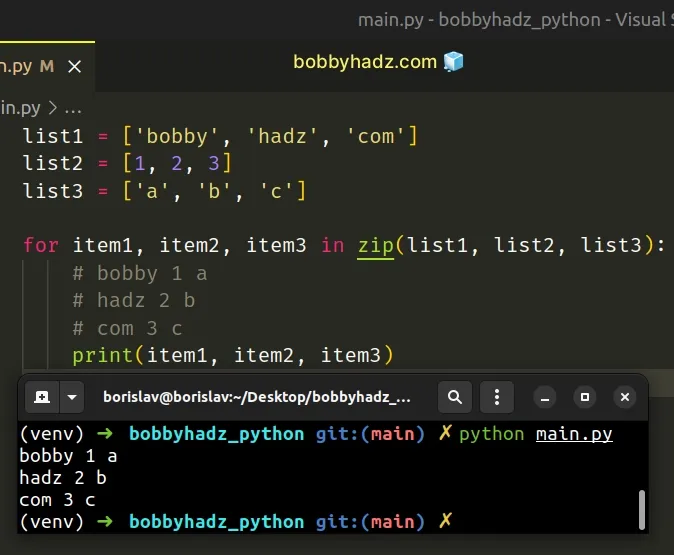
The zip() function iterates over several iterables in parallel and produces tuples with an item from each iterable.
The zip function returns an iterator of tuples.
list1 = ['bobby', 'hadz', 'com'] list2 = [1, 2, 3] list3 = ['a', 'b', 'c'] # 👇️ [('bobby', 1, 'a'), ('hadz', 2, 'b'), ('com', 3, 'c')] print(list(zip(list1, list2, list3)))
0, the second tuple consists of the elements in each list that have an index of 1, etc.# Declare as many variables as there are items in each tuple
Make sure to declare exactly as many variables as there are items in each tuple.
list1 = ['bobby', 'hadz', 'com'] list2 = [1, 2, 3] # 👇️ [('bobby', 1), ('hadz', 2), ('com', 3)] print(list(zip(list1, list2))) for item1, item2 in zip(list1, list2): # bobby 1 # hadz 2 # com 3 print(item1, item2)
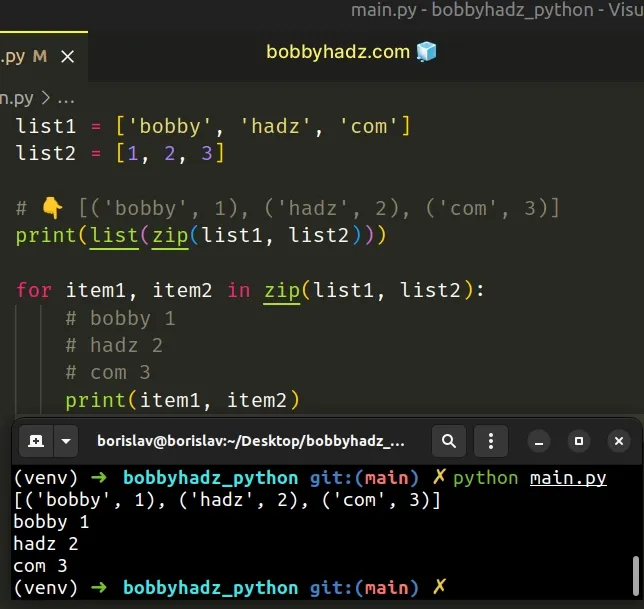
If you try to unpack more or fewer variables than there are items in each tuple, you'd get an error.
for loop when iterating over two-dimensional lists, lists of tuples, etc.# Using multiple variables in a For loop with two-dimensional list
Here is an example of
unpacking variables in a
for loop when iterating over a two-dimensional list.
two_dimensional_list = [ ['bobby', 1], ['hadz', 2], ['com', 3] ] for first, second in two_dimensional_list: # bobby 1 # hadz 2 # com 3 print(first, second)
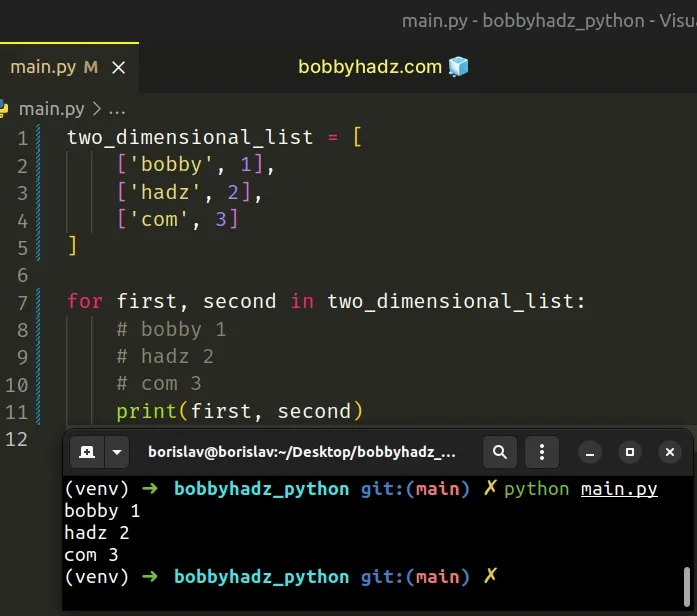
The first variable gets assigned the first element of the nested list of the
current iteration and the second variable gets assigned the second element.
When you use unpacking, you have to make sure to unpack exactly as many variables as there are values in the iterable, otherwise an error is raised.
Here is an example that doesn't unpack the values of each tuple.
list1 = ['bobby', 'hadz', 'com'] list2 = [1, 2, 3] for tup in zip(list1, list2): # bobby 1 # hadz 2 # com 3 print(tup[0], tup[1])
If not all nested sequences have the same length, access each sequence at an index.
list_of_lists = [ ['bobby', 1, 'a'], ['hadz', 2, 'b'], ['com', 3, 'c', 'xyz', 123] ] for sublist in list_of_lists: # bobby 1 a # hadz 2 b # com 3 c print(sublist[0], sublist[1], sublist[2])
The last sublist has more items than the previous two, so unpacking is not an option.
If you need to iterate over the key-value pairs of a dictionary in a for loop,
use the dict.items() method.
# Using multiple variables in a For loop using dict.items()
This is a three-step process:
- Use the
dict.items()method to get a view of the dictionary's items. - Use a
forloop to iterate over the view object. - Unpack the key and value into variables.
my_dict = { 'first': 'bobby', 'last': 'hadz', 'age': 30 } for key, value in my_dict.items(): # first bobby # last hadz # age 30 print(key, value)
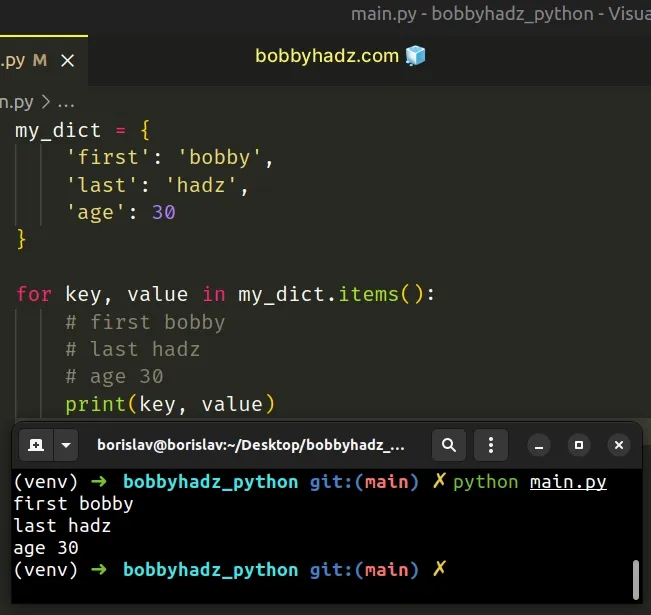
The dict.items() method returns a new view of the dictionary's items ((key, value) pairs).
my_dict = { 'first': 'bobby', 'last': 'hadz', 'age': 30 } # 👇️ dict_items([('first', 'bobby'), ('last', 'hadz'), ('age', 30)]) print(my_dict.items())
On each iteration of the for loop, we unpack the current key and value into
variables.
If you need to get access to the index of the current iteration in a for loop,
use the enumerate() function.
# Using multiple variables in a For loop using enumerate()
This is a three-step process:
- Use the
enumerate()function to get access to the current index. - Use a
forloop to iterate over theenumerateobject - Unpack the current item and index into variables.
a_list = ['bobby', 'hadz', '.com'] for index, item in enumerate(a_list): # bobby 0 # hadz 1 # .com 2 print(item, index)
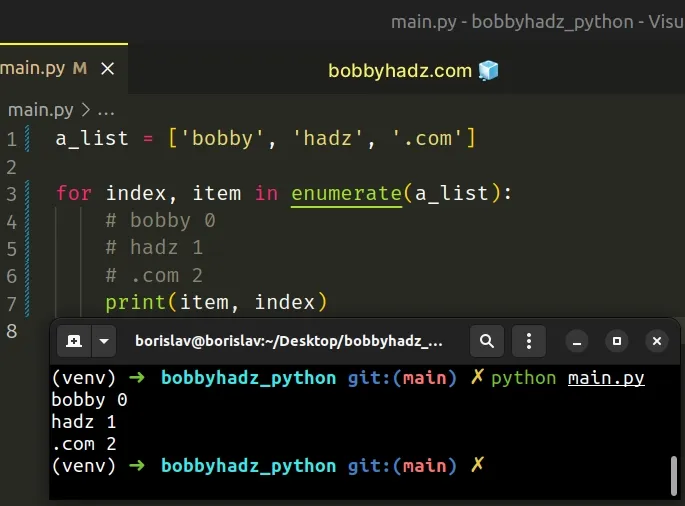
The enumerate() function takes an iterable and returns an enumerate object containing tuples where the first element is the index and the second is the corresponding item.
a_list = ['bobby', 'hadz', '.com'] # 👇️ [(0, 'bobby'), (1, 'hadz'), (2, '.com')] print(list(enumerate(a_list)))
On each iteration of the for loop, we unpack the current index and item into
variables.
# Using 2 variables in a For loop to simulate a nested loop
If you need to use 2 variables in a for loop to simulate a nested for loop,
use the itertools.product() class.
from itertools import product list_1 = ['bobby', 'hadz', 'com'] list_2 = [1, 2, 3] # bobby 1 # bobby 2 # bobby 3 # hadz 1 # hadz 2 # hadz 3 # com 1 # com 2 # com 3 for item_1, item_2 in product(list_1, list_2): print(item_1, item_2)

The
itertools.product()
method is roughly equivalent to a nested for loop.
For each item in list_1, the for loop iterates over each item in list_2.
Here is an example of a nested for loop that achieves the same result.
list_1 = ['bobby', 'hadz', 'com'] list_2 = [1, 2, 3] # bobby 1 # bobby 2 # bobby 3 # hadz 1 # hadz 2 # hadz 3 # com 1 # com 2 # com 3 for item_1 in list_1: for item_2 in list_2: print(item_1, item_2)
# Additional Resources
You can learn more about the related topics by checking out the following tutorials:

